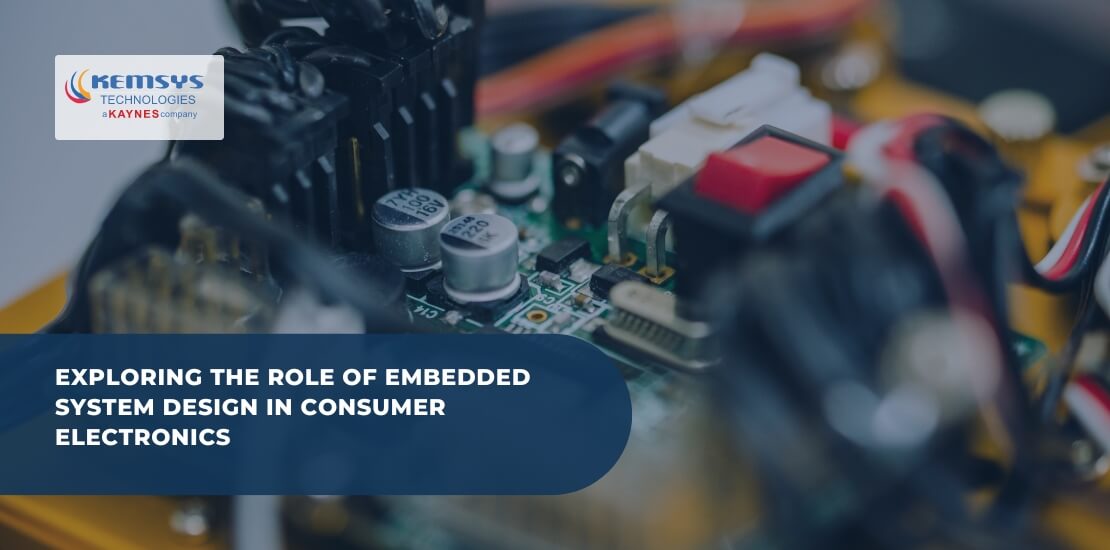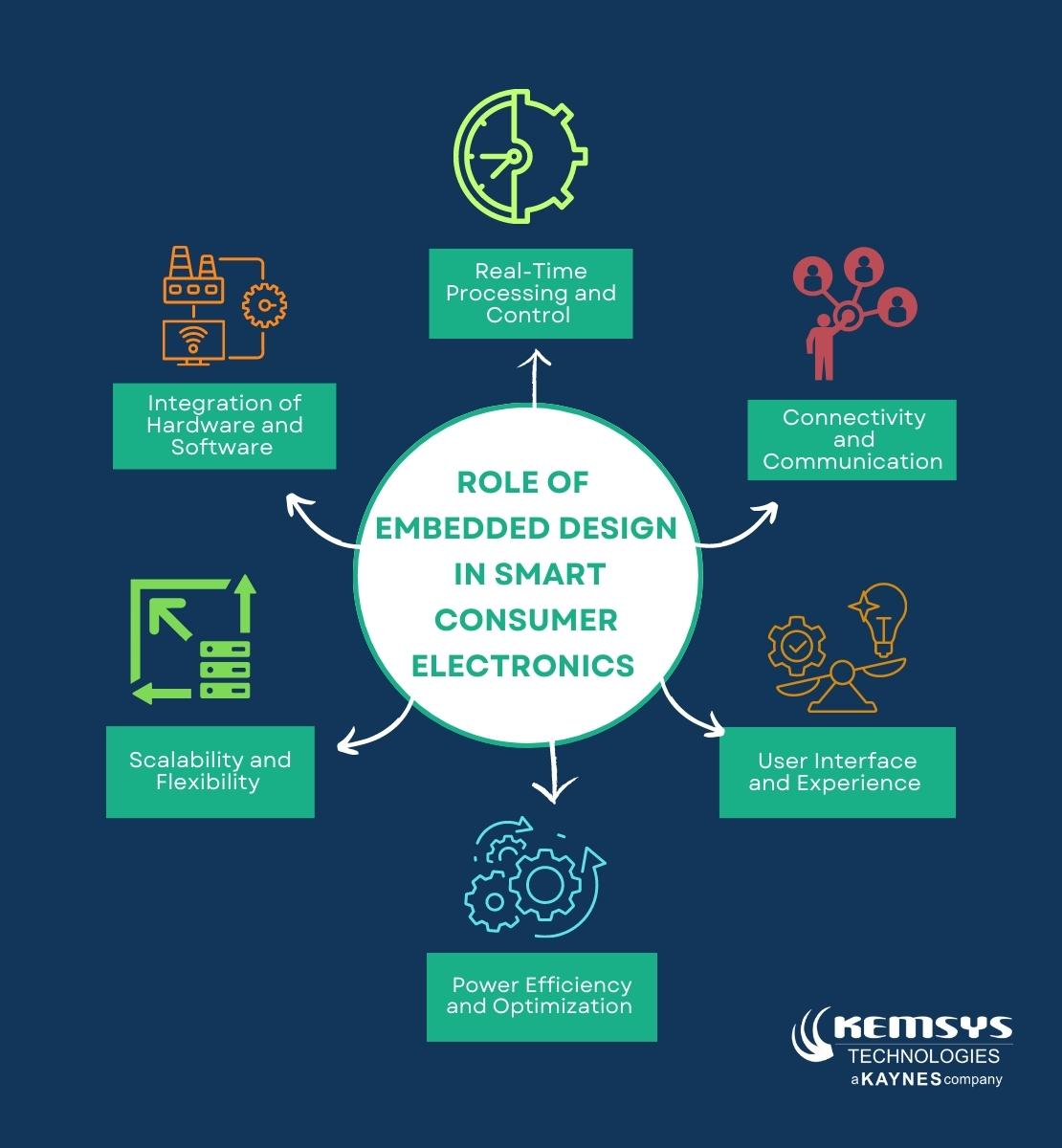- June 9, 2023
- Posted by: Kajal Sharma
- Categories: Device Engineering, Internet of Things

In our interconnected era, devices have become more than mere tools; they have become indispensable companions that empower and enrich our lives. At the heart of this transformation lies the ingenious embedded system design, which act as the driving force behind the seamless functionality and remarkable capabilities of our connected devices.
Join us as we embark on an exploration into the captivating world of embedded system design, unraveling its pivotal role in empowering connected devices.
From smartphones and smart homes to wearable technology and automotive marvels, embedded system design is the unseen architect that brings these cutting-edge technologies to life.
In this captivating journey, we will uncover the intricate workings of embedded system design, where hardware and software intertwine to create seamless experiences.
We will delve into the world of microcontrollers, sensors, actuators, communication interfaces, and intelligent algorithms, understanding how their careful integration enables devices to communicate, process data, and make intelligent decisions.
Discover how embedded system design enables devices to connect, control, and adapt to our needs, forming a dynamic ecosystem of interconnected devices.
From personalized user experiences and efficient automation to real-time data analysis and seamless connectivity, embedded system design shapes the way we interact with and benefit from consumer electronics.
Together, let us explore the boundless possibilities and empowering potential that embedded system design brings to connected devices. Witness the transformative impact it has on our daily lives, opening doors to innovation, convenience, and enhanced capabilities.
Let’s discuss the intricate world where technology and design converge, empowering our devices to shape a more connected and empowered future.
The Evolution of Embedded Systems in Consumer Electronics
Embedded systems are specialized computer systems integrated into devices to perform dedicated functions, such as in smart home devices, automotive systems, and medical devices.
Over the years, consumer electronics have witnessed a remarkable transformation, thanks to the evolution of embedded systems.
These sophisticated systems, which consist of hardware and software components integrated into a single device, have played a pivotal role in revolutionizing the functionality and capabilities of various consumer electronics.
In the early days, embedded systems were primarily used for basic tasks such as controlling simple functions in devices like microwaves, televisions, and washing machines.
However, as technology advanced, so did the capabilities of embedded systems. They became more powerful, compact, and energy-efficient, enabling their integration into a wide range of consumer electronics, including smartphones, smart TVs, wearables, and home automation devices.
The evolution of embedded systems has brought about several significant changes in consumer electronics.
Firstly, it has facilitated seamless connectivity between devices, enabling them to communicate and share data in real-time. This has paved the way for the Internet of Things (IoT), where embedded systems act as the backbone of interconnected devices in smart homes, healthcare systems, and transportation networks.
Secondly, embedded systems have enhanced the user experience by enabling advanced functionalities and features. From intuitive touchscreens and voice recognition to gesture control and augmented reality, embedded systems have made consumer electronics more interactive and user-friendly.
Furthermore, embedded systems have contributed to the miniaturization of devices without compromising their performance. This has led to the proliferation of wearable devices such as smartwatches and fitness trackers, which seamlessly integrate into our daily lives.
Looking ahead, the evolution of embedded systems in consumer electronics shows no signs of slowing down. With advancements in artificial intelligence, machine learning, and edge computing, embedded systems are expected to become even more intelligent, capable, and integral to the future of consumer electronics. They will continue to empower connected devices, enabling a more convenient, efficient, and personalized user experience.
Key Components of Embedded Systems
Embedded systems are a vital part of many devices we use every day, from smartphones and smartwatches to kitchen appliances and cars. To understand their role, let’s take a closer look at the key components that make up these systems.
- Microcontroller: At the heart of an embedded system is a microcontroller, a small computer on a single integrated circuit. It consists of a central processing unit (CPU), memory, and input/output peripherals. The microcontroller executes software programs and controls the overall operation of the device.
- Sensors: Sensors gather data from the device’s environment. They can measure things like temperature, pressure, motion, light, and more. The data collected by sensors is used by the embedded system to make decisions or trigger specific actions.
- Actuators: Actuators are components that perform physical actions based on the instructions received from the embedded system. Examples include motors, solenoids, relays, and displays. Actuators allow the embedded system to interact with its surroundings or provide feedback to the user.
- Memory: Embedded systems require memory to store the software program that controls the device’s operation. They also use memory to store data collected from sensors or user inputs. There are different types of memory, including random-access memory (RAM) for temporary storage and read-only memory (ROM) for permanent storage.
- Communication Interfaces: Embedded systems often need to communicate with other devices or systems. Communication interfaces such as Wi-Fi, Bluetooth, USB, or Ethernet enable data exchange, allowing the device to connect to networks, transfer data, or interact with other devices.
- Power Management: Embedded systems need a reliable power source to function properly. Power management components ensure efficient power usage and can include batteries, power regulators, and power-saving techniques to extend the device’s battery life.
The role of embedded systems is to bring intelligence and functionality to devices. They process data from sensors, make decisions based on programmed logic, and control the device’s behavior through actuators. Embedded system design enables devices to automate tasks, provide interactivity, and deliver a seamless user experience.
What is Embedded System Design and What role it plays in Smart Consumer Electronics
Embedded system design refers to the process of creating and developing the hardware and software components of an embedded system. It involves designing and integrating the necessary components to meet specific requirements and functionality.
In the context of smart consumer electronics, embedded system design plays a crucial role in enabling the advanced features, seamless connectivity, and intelligent functionalities that we enjoy in our devices.
Here are some key roles that embedded system design plays in smart consumer electronics:

Integration of Hardware and Software
Embedded system design involves the integration of hardware components like microcontrollers, sensors, actuators, and communication interfaces with software programs.
This integration ensures that the hardware and software work together harmoniously to deliver the desired functionalities and user experiences.
Real-Time Processing and Control
Smart consumer electronics often require real-time processing and control capabilities.
Embedded systems are designed to handle real-time tasks efficiently, enabling devices to respond promptly to user inputs, environmental changes, or incoming data streams.
This allows for seamless interaction and smooth operation of the smart device.
Connectivity and Communication
Embedded system design enables smart consumer electronics to connect and communicate with other devices or networks.
Whether it’s through Wi-Fi, Bluetooth, NFC, or other wireless protocols, embedded systems facilitate data exchange, synchronization, and remote control.
This wireless connectivity enables devices to access online services, share data with other devices, and integrate into larger smart ecosystems.
Read more – Why wireless connectivity is important?
User Interface and Experience
It also plays a significant role in creating intuitive user interfaces and enhancing user experiences.
It involves designing responsive touchscreens, voice recognition systems, gesture controls, or any other user interaction mechanisms.
Embedded systems process user inputs, interpret commands, and provide appropriate feedback, ensuring a seamless and engaging user experience.
Power Efficiency and Optimization
It focuses on power efficiency and optimization, particularly in battery-powered consumer electronics.
Designers employ various techniques such as power management circuits, sleep modes, and low-power components to maximize battery life without compromising performance.
This ensures that smart devices can operate for extended periods without frequent recharging.
Scalability and Flexibility
Embedded system design allows for scalability and flexibility in smart consumer electronics.
Manufacturers can create devices with varying capabilities by selecting appropriate components, adding or removing features, and updating firmware.
This scalability ensures that devices can adapt to changing user needs or accommodate future upgrades and enhancements.
From Chips to Connectivity: The Impact of Embedded Systems
Embedded systems have come a long way, evolving from simple chips to becoming the driving force behind connectivity in modern technology. The impact of embedded systems can be seen in various aspects of our lives.
Let’s explore how these systems have revolutionized connectivity and transformed the way we interact with devices.
Integration of Functionality
Embedded systems have enabled the integration of multiple functionalities within a single device.
Devices that once had limited capabilities can now perform a wide range of tasks.
For example, smartphones have embedded systems that incorporate communication, multimedia, navigation, and sensor functionalities, all in one compact device.
Seamless Connectivity
For seamless connectivity embedded systems play a vital role in enabling seamless connectivity between devices.
Through technologies like Wi-Fi, Bluetooth, and cellular networks, embedded systems facilitate communication and data exchange between devices, creating a connected ecosystem.
This connectivity has paved the way for advancements on the Internet of Things (IoT) and smart homes, where devices can interact with each other and with the user.
Empowering Wearable Devices
From smartwatches and fitness trackers to augmented reality glasses, embedded systems enable these devices to collect data, process information, and provide real-time feedback to the user.
This has revolutionized personal health monitoring, fitness tracking, and even augmented reality experiences.
Enabling Smart Home Automation
Today, technologies have transformed the way we manage our homes.
With embedded systems integrated into home automation devices, we can control and monitor various aspects of our homes remotely.
From adjusting the thermostat and turning off lights to receiving security alerts, embedded systems have made our homes smarter and more convenient.
Enhancing Industrial Automation
Embedded systems have a profound impact on industrial automation.
They enable sophisticated control systems, monitoring equipment, and real-time data analysis.
Embedded systems power robotic automation, process control systems, and predictive maintenance, increasing efficiency, accuracy, and productivity in various industries.
Enriching User Experience
In enhancing user experience embedded systems play a crucial role.
They enable intuitive user interfaces, such as touchscreens and voice recognition which makes devices more user-friendly and interactive.
Embedded systems also support personalized experiences by analyzing user data and adapting to individual preferences.
Conclusion
The evolution of embedded systems in consumer electronics has revolutionized our interactions with technology. Through the integration of key components and the driving force of connectivity, these systems have empowered devices to deliver seamless functionality and enhanced user experiences.
By unveiling their inner workings, we have witnessed their intricate design and the role they play in connecting, controlling, and optimizing our everyday gadgets. From chips to connectivity, embedded systems have transformed devices into indispensable companions in our lives.
As we look to the future, we can expect further advancements in artificial intelligence and edge computing. Solidifying the vital role of embedded systems in shaping the future of consumer electronics. Their impact will continue to be felt, enabling us to embrace the boundless potential of technology in our daily lives.
Read More
- Subscription-Based IoT Devices: A New Consumer Trend in the U.S.
- Cybersecurity in Embedded Systems: Protecting Devices in an Increasingly Connected World
- Hardware Devices Compliance, Standards, and Regulatory Requirements for the USA
- Key Features to Look for in Customizable IoT Asset Management Platform
- Real-Time Detection of Leaks with IoT-Based Asset Management

